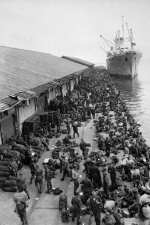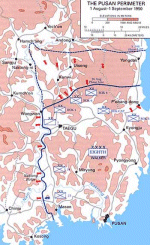
1018154002 |
643k |
Namesake
Pusan - Pusan Perimeter (Korean War), 1950. Spearheaded by tanks, the army of North Korea crossed the 38th parallel at several points on June 25 and plunged
southward into the Republic of Korea. Caught unprepared, the South Korean army of Gen. Chae Byong Duk reeled back from the 200-mile border. The capital of
Seoul fell in three days as the North Koreans under Gen. Chai Ung Chai bridged the Han River on June 30 and pressed forward down the length of the peninsula. Under
the auspices of the United Nations, Gen. Douglas MacArthur flew in United States troops from Japan to aid the South Koreans. The first American ground forces (700
men from the 24th Infantry Division under Col. Charles Smith) took up positions at Osan, 30 miles south of Seoul, on July 5. Without effective antitank weapons, the
combined American-South Korean forces could not halt the armored thrusts of the Russian-made T-34 tanks employed by the North Koreans. About 150 Americans
were killed, wounded, or missing in the first Communist attack. As more United States units arrived by air and sea, Gen. William Dean of the 24th Division
committed them in a series of delaying actions along the vital Seoul-Taejon-Pusan axis. But the retreat continued. Taejon fell on July 20. Dean himself was wounded
and later captured. Meanwhile, on July 13 Gen. Walton Walker had assumed command of the United States Eighth Army in Korea, which soon included the 1st
Cavalry and 25th Infantry (and later the 2nd Infantry) divisions, as well as marines. Despite American dominance of the air and sea, the Eighth Army and South Korean
units were pushed back to the Naktong River by August 5. Pohang, 63 miles northeast of Pusan, fell on August 11. In a perimeter around the key port of Pusan,
in the southeast, the Eighth Army dug in for a desperate defense. The North Koreans, who had suffered an estimated 58,000 casualties in their drive southward,
hammered at the perimeter defenses and managed to secure several bridgeheads across the Naktong, in the west. Taegu, 55 miles to the northwest, and Masan, 29
miles west, was seriously threatened. But Walker made maximum use of his interior-line position to shift reserves to trouble spots. By the end of August all 56
Communist penetration attempts had been checked or eliminated. At that time Walker commanded 91.500 Republic of Korea (ROK) troops, 87.000 Americans,
and 1,500 British. In September the fighting at the edge of the perimeter showed a gradual diminishment of North Korean offensive power. Meanwhile in Japan,
MacArthur organized an amphibious strike behind the Communist lines in the Seoul area.
Photo - U.S. troops debarking at Pusan, South Korea, 6 August 1950. U.S. National Archives file #: 111-SC-345283 War & Conflict Book #: 1382, U.S. Army Signal Corps photo by Sgt Dunlap.
Map - The Pusan Perimeter, 1 August-1 September 1950, Center for Military History
| Tommy Trampp |

